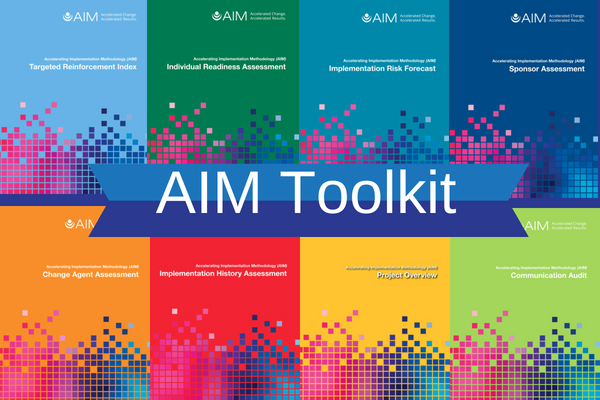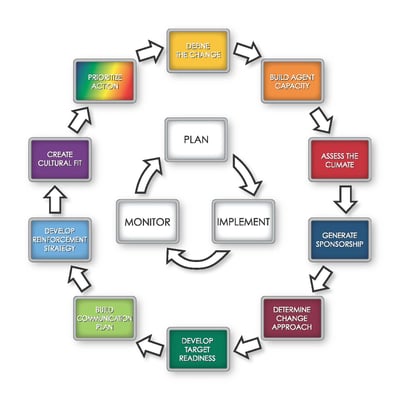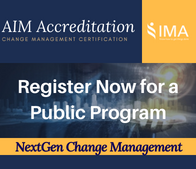Prospective clients interested in AIM inevitably ask, “What’s included in your Toolkit?” This question always causes us to hesitate, because yes, there is a toolkit; however, unlike some of our competitors, we understand change management, when done right, is really about targeting your organization’s limited resources for the most impact in the shortest amount of time to get to value realization at speed. 
The fact is, when our own Change Management Consultants work on a project, we never use all our tools! If the tool is not going to add to achieving the intended business outcomes faster, we don’t use it.
The AIM Change Management Methodology is an integrated system of practical strategies, tactics, tools and measurement diagnostics, all based around 10 core change actions. The corresponding tool is designed to provide analysis and insight into current pressure points. By using these tools, Change Agents have the analytical data needed to precisely assess current risks. This gives Agents the information they need to focus their time where it will have the most impact.
The AIM Toolkit
Below is a description of each of our AIM Tools listed by the related core change action. Each tool is available as a web-based Assessment or in paper version.
Define the Change
The Project Overview Tool enables key players on a project to align on a clear and commonly held definition of the change from an implementation Frame of Reference, including:
- Definition of the problem: why are we changing?
- Starting point: the present state
- Ending point: the desired state
- Measures for success: the monitoring and feedback system
Answers to these questions are a minimum critical requirement for successfully initiating a change.
Build Agent Capacity
The Change Agent Assessment Tool analyzes the skills, experience, and relationships required by Change Agents to successfully implement the change. It can be used to:
- Select Change Agents for current and future projects
- Assess Change Agent capabilities and identify potential needs for additional training and motivation
- Evaluate the performance of Change Agents
- Ensure that the team of Change Agents have all the key characteristics for successful implementation
Assess the Climate
The Implementation History Assessment predicts the likelihood of future implementation success based on an organization’s history of prior implementations. It identifies cultural, systemic “success patterns” and areas of risk, and is used to identify those actions that will have greatest impact on overcoming past barriers. A history of poorly executed changes can result in your employees’ belief that the current changes may also be ineffectively implemented. The goal is to identify 2-3 key opportunities to do something different in how a change is implemented, and also to take advantage of past effective strategies. The Assessment can be used to provide data on change capability over time.
The Organizational Stress Test is an evaluation of the priorities competing for resources in your organization. Major organizational changes do not occur in isolation; they occur in the context of stress from everyday workloads and from other changes which are or have recently occurred in the organization.
Generate Sponsorship
The Sponsor Assessment Tool assesses the level of observable commitment of an individual Sponsor to change. It identifies specific behaviors leaders must use to demonstrate their genuine commitment to specific business changes - how to express, model and reinforce private and public commitment to a change for maximum impact on the implementation. It can be completed:
- By Sponsors to self-assess their level of commitment
- By Change Agents and employees to capture their perceptions of the Sponsor’s commitment
- As a 360° feedback tool for a specific Sponsor
The results can be used to pinpoint messages and behaviors that will have a high return on investment.
Develop Target Readiness 
The Individual Readiness Assessment is newly revised, and analyzes the readiness for change for any impacted group or individual. The objective is to generate specific strategies to manage resistance. By comparing the results of Sponsors, Change Agents, and/or Targets, Agents can assess various Frames of Reference on where there are barriers to achieving adoption for a change.
The new, updated version includes an assessment of levels of disruption as perceived by various Target groups and Sponsors. Disruption scores are then subtracted from the Readiness score, since the level of disruption indicates the anticipated degree of resistance.
Results are then scored to assess where this change currently falls in the context of achieving Installation or Implementation.
Build Communication Plan
The Communication Audit assesses both the content and process of communication for an implementation, and how the communication plan reflects the key principles of successful implementation. It also matches the content of messages with the psychological needs of people impacted by the change to maximize understanding and aid in building commitment. The Audit can be used in all phases of a project:
- At the beginning of a change in the “Unfreezing” stage to assess how well the organization has initiated a change
- In the “Transition” stage to assess how well the process is being delivered into the system
- In the “Re-freezing” stage to identify opportunities for maximum communication and accelerate implementation
Develop Reinforcement Strategy
The Targeted Reinforcement Index assesses the effectiveness of the current reinforcement between the manager and the direct report. It also provides keys to improving motivation by giving managers those specific reinforcements that will be meaningful to an individual or a group of Targets. The data provided can be used as:
- A performance management tool
- A means of providing practical formal and informal reinforcements that will motivate behavior change
- A means for balancing positive rewards with negative consequences
Prioritize Action
The Implementation Risk Forecast provides a “snapshot” measurement designed to increase the probability of implementation success by identifying current risk factors for a project in progress. It can be used at milestone points in the project to show progress over time.
Next Generation Change Management is an exercise in power and politics, where influence is used to achieve the needed business results. Rather than spending time completing tools and templates, Change Agents need to be contracting with both the Authorizing and Reinforcing Sponsors at each level to ensure they are Expressing, Modeling, and most importantly, Reinforcing the behaviors they seek to see. The AIM toolkit supports this process by helping Agents focus on the actions that will have the most amount of impact using the fewest amount of resources in the shortest amount of time.
If you are interested in a by distance look at the tools, contact us. Please note we don’t sell tools to individuals who have no formal training in AIM.


